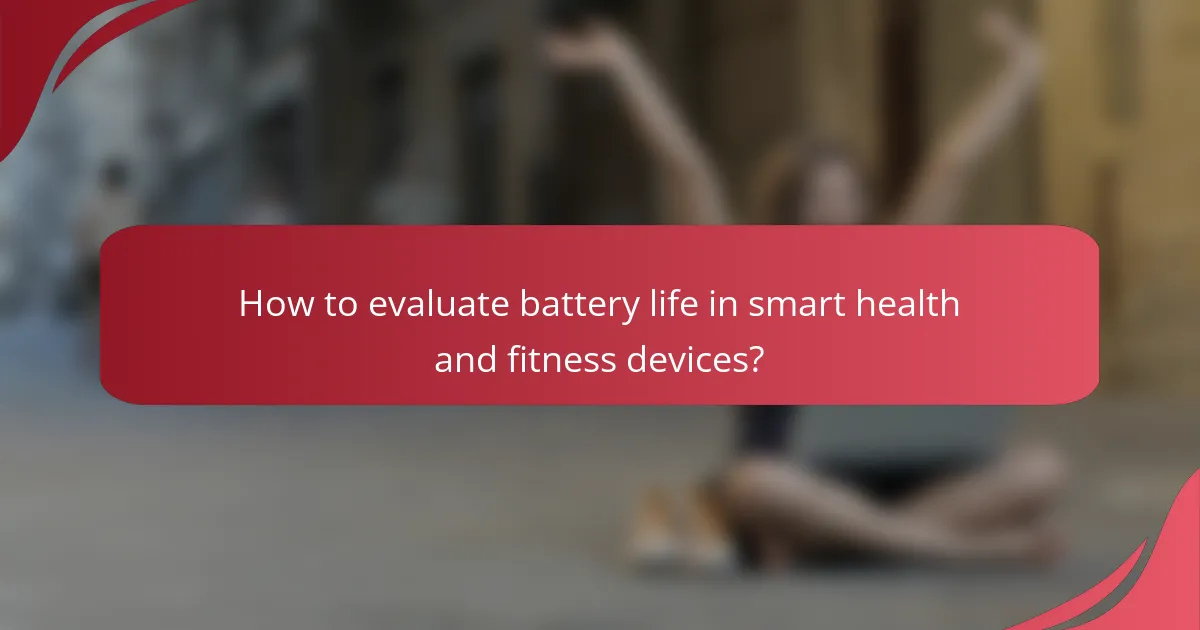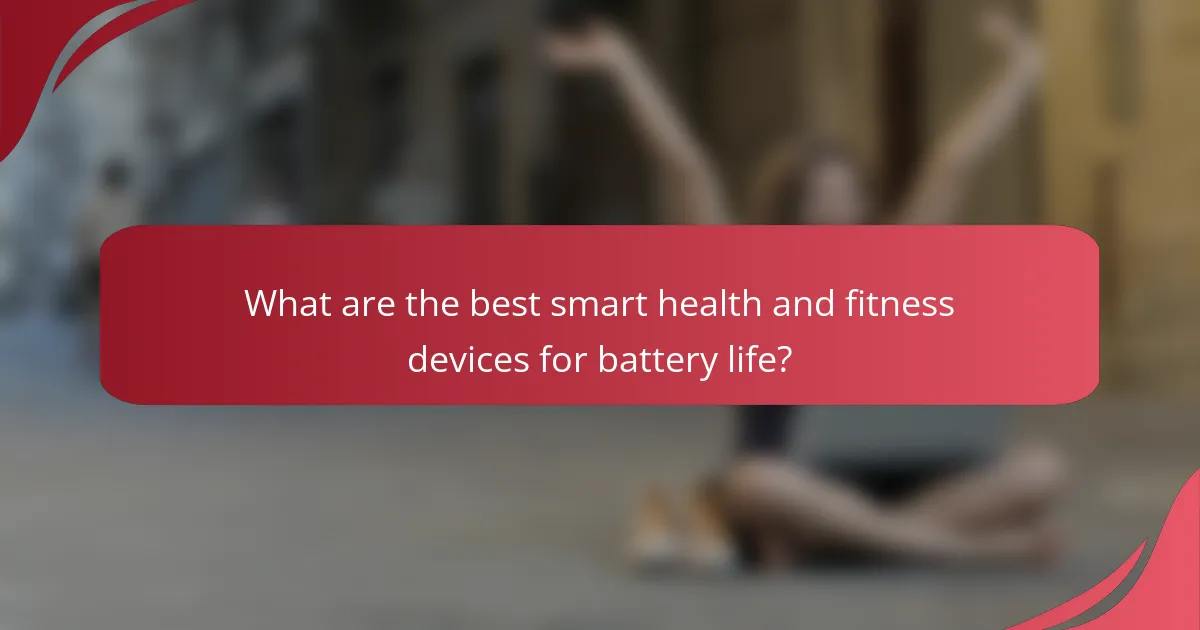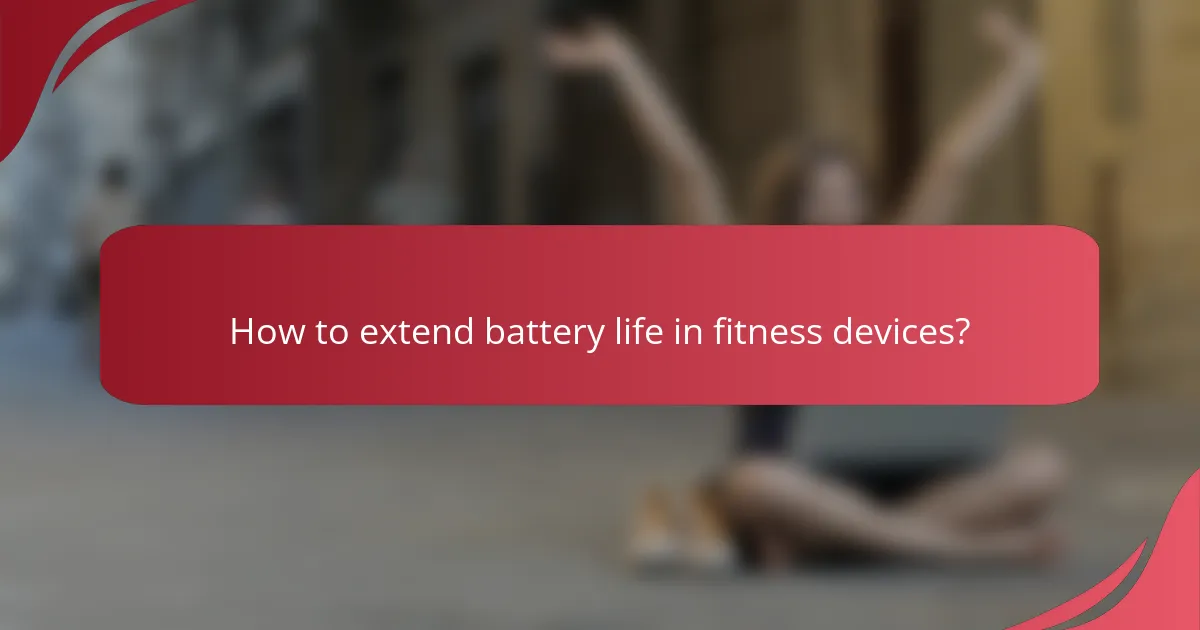Smart health and fitness devices have become essential tools for tracking wellness, but their effectiveness often hinges on battery life. Evaluating how long a device can operate under typical usage conditions is crucial for setting realistic performance expectations. A device with extended battery life can provide uninterrupted monitoring, ensuring that users receive consistent and accurate fitness insights.

How to evaluate battery life in smart health and fitness devices?
To evaluate battery life in smart health and fitness devices, consider the device’s usage patterns and the manufacturer’s specifications. Understanding how long a device lasts under typical conditions helps set realistic expectations for performance.
Battery life metrics
Battery life metrics typically include standby time, active usage time, and charging cycles. Standby time refers to how long a device can remain powered on without active use, while active usage time indicates how long it can operate during regular use. Charging cycles represent the number of times a battery can be charged before its capacity significantly diminishes.
For example, a fitness tracker may boast a standby time of several days but only last a few hours during continuous heart rate monitoring. It’s crucial to assess these metrics based on your intended usage to avoid disappointment.
Real-world usage examples
Real-world usage can vary widely based on how you use the device. For instance, a smartwatch used primarily for notifications may last up to a week, while one used for GPS tracking during workouts might only last a couple of days. Understanding your habits can help you choose a device that meets your needs.
Consider how often you charge your device and the activities you engage in. Devices with features like always-on displays or continuous health monitoring will generally require more frequent charging.
Manufacturer specifications
Manufacturer specifications provide essential insights into expected battery performance. Look for details on battery capacity, estimated usage times, and any power-saving features that may extend battery life. These specifications can often be found in product manuals or on the manufacturer’s website.
Keep in mind that real-world performance may differ from what is advertised. Factors such as software updates, environmental conditions, and individual usage patterns can all impact battery life. Always cross-reference user reviews to gauge actual performance over time.

What are the best smart health and fitness devices for battery life?
The best smart health and fitness devices for battery life typically offer several days to weeks of usage on a single charge. When evaluating these devices, consider factors such as usage patterns, features, and the type of activities you engage in.
Fitbit Charge 5
The Fitbit Charge 5 is known for its impressive battery life, lasting up to seven days depending on usage. This device features built-in GPS, heart rate monitoring, and sleep tracking, which can impact battery longevity based on how frequently these features are used.
To maximize battery life, users should adjust settings such as screen brightness and notification frequency. Regular software updates can also enhance performance and efficiency, ensuring you get the most out of your device.
Garmin Forerunner 245
The Garmin Forerunner 245 offers a robust battery life of up to seven days in smartwatch mode and up to 24 hours in GPS mode. This makes it an excellent choice for runners and outdoor enthusiasts who need reliable tracking without frequent recharging.
Users can extend battery life by disabling features like music playback or reducing the GPS sampling rate. The Forerunner 245’s training features are designed to balance performance and battery consumption, allowing for efficient usage during long workouts.
Amazfit Bip U Pro
The Amazfit Bip U Pro stands out with a battery life of up to nine days under typical usage. This smartwatch includes features like built-in GPS, SpO2 monitoring, and sleep tracking, all while maintaining energy efficiency.
To optimize battery performance, consider using the device’s power-saving mode during less active days. Regularly syncing data and managing notifications can also help maintain a longer battery life, making it a practical option for daily wear.
![]()
How does battery life affect performance in fitness trackers?
Battery life significantly impacts the performance of fitness trackers by determining how long the device can accurately monitor activities without needing a recharge. A shorter battery life can lead to missed data and interruptions in tracking, affecting overall fitness insights.
Impact on tracking accuracy
Fitness trackers rely on continuous power to provide accurate readings of metrics such as heart rate, steps, and sleep patterns. If the battery is low, the device may reduce its tracking frequency or turn off certain features, leading to incomplete or inaccurate data. For example, a tracker with a battery life of only a few hours may not capture an entire workout session, resulting in gaps in performance analysis.
Users should consider the battery life specifications when selecting a fitness tracker, as devices with longer battery life, typically ranging from several days to weeks, tend to maintain consistent tracking accuracy. Regularly charging the device can help mitigate accuracy issues, but it may not always be convenient.
Effect on user experience
A fitness tracker’s battery life directly influences the user experience by affecting convenience and usability. Devices that require frequent charging can be cumbersome, especially for users who engage in daily workouts or outdoor activities. A tracker that lasts several days without needing a charge allows users to wear it continuously without interruption.
Moreover, a longer battery life enhances the overall satisfaction with the device, as users can rely on it for extended periods without the anxiety of running out of power. It’s advisable to choose a tracker that aligns with your activity level and charging habits to ensure a seamless experience.

What are the expectations for battery longevity?
Battery longevity expectations for smart health and fitness devices typically range from several days to a few weeks, depending on usage and device type. Users generally anticipate that their devices will last long enough to avoid frequent recharging, enhancing convenience and usability.
Average battery life benchmarks
Smart health and fitness devices vary widely in battery life, with average benchmarks often falling between 5 to 14 days. For example, fitness trackers may last longer than smartwatches due to fewer features and lower power consumption. Devices with GPS and continuous heart rate monitoring tend to have shorter battery lives, sometimes requiring daily charging.
Some high-end models, particularly those designed for athletes, can offer battery life extending up to several weeks in low-power modes. It’s essential to consider the specific features and settings that impact battery performance when evaluating devices.
Consumer expectations
Consumers expect smart health and fitness devices to provide reliable battery life that aligns with their active lifestyles. Many users prefer devices that can last at least a week without needing a charge, as this reduces the hassle of frequent recharging.
Additionally, users often look for features like battery-saving modes and notifications for low battery status. Understanding these expectations can help manufacturers design products that meet consumer needs while balancing performance and longevity.

What factors influence battery life in smart devices?
Battery life in smart health and fitness devices is influenced by several key factors, including usage patterns, device features, and environmental conditions. Understanding these elements can help users manage expectations and optimize performance.
Usage patterns
The way users interact with their smart devices significantly impacts battery life. For instance, frequent use of GPS tracking, heart rate monitoring, or notifications can drain the battery more quickly than basic functions like timekeeping. Users should consider adjusting settings or limiting features during less active periods to extend battery longevity.
Additionally, the frequency of syncing data with smartphones or other devices can affect battery performance. Regular syncing may lead to higher energy consumption, so users might benefit from scheduling syncs during specific times rather than continuously.
Device features
Smart devices come equipped with various features that can either enhance functionality or consume more power. Features such as high-resolution displays, continuous health monitoring, and advanced connectivity options (like Bluetooth and Wi-Fi) typically require more energy. Users should evaluate which features they truly need and disable those that are not essential to conserve battery life.
Moreover, the type of sensors used in the device can play a significant role. For example, devices with multiple sensors for tracking different health metrics may have shorter battery life compared to simpler models. Users should weigh the benefits of advanced features against their impact on battery performance.
Environmental conditions
Environmental factors, such as temperature and humidity, can also influence battery life. Extreme temperatures, both hot and cold, can reduce battery efficiency and lifespan. Users should avoid exposing their devices to harsh conditions, as this can lead to quicker battery depletion.
Additionally, high humidity levels can affect the internal components of devices, potentially leading to malfunctions that impact battery performance. Keeping devices in a stable, moderate environment can help maintain optimal battery function over time.

How to extend battery life in fitness devices?
To extend battery life in fitness devices, users can implement various strategies that optimize power consumption. These methods include utilizing power-saving modes, adjusting app settings, and ensuring regular updates to the device software.
Power-saving modes
Most fitness devices come equipped with power-saving modes that significantly reduce energy consumption. Activating these modes often dims the screen, limits connectivity, and decreases tracking frequency, which can extend battery life by several hours or even days, depending on usage.
When using power-saving modes, be aware that some features may be disabled or limited. For instance, continuous heart rate monitoring might be paused, so consider your fitness goals when deciding to enable these settings.
App settings adjustments
Adjusting app settings can greatly impact battery performance. Features such as GPS tracking, notifications, and background syncing can drain battery life quickly. Turning off unnecessary notifications and limiting GPS use to essential activities can help conserve power.
Additionally, consider reducing the frequency of data syncing with companion apps. Instead of real-time updates, syncing data every few hours can help maintain battery longevity without sacrificing too much functionality.
Regular updates
Keeping your fitness device updated with the latest software is crucial for optimal performance and battery efficiency. Manufacturers often release updates that include improvements to battery management and overall device functionality.
Check for updates regularly, as they can fix bugs that may cause excessive battery drain. Most devices allow you to enable automatic updates, ensuring you always have the latest features and optimizations without manual intervention.


